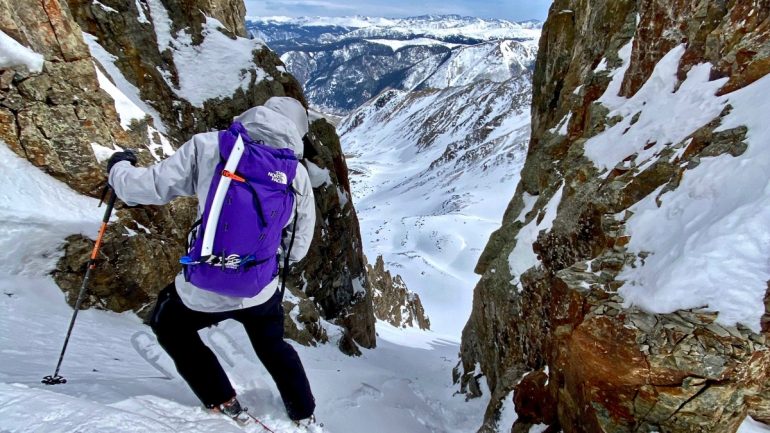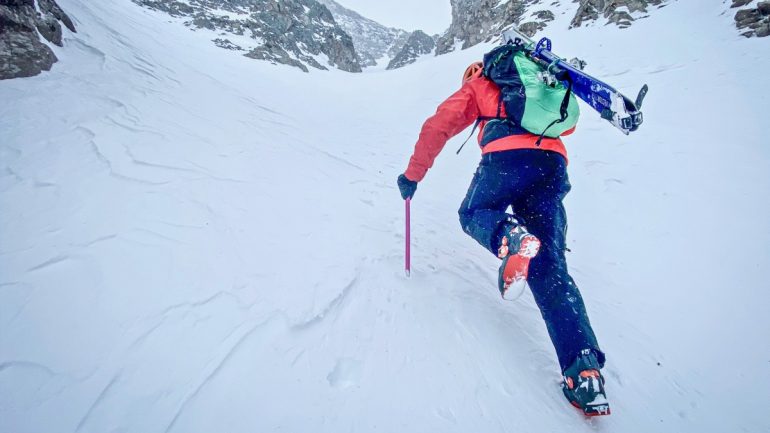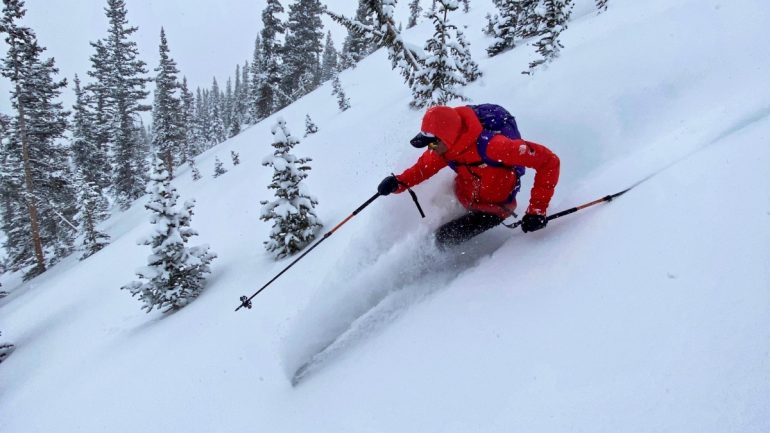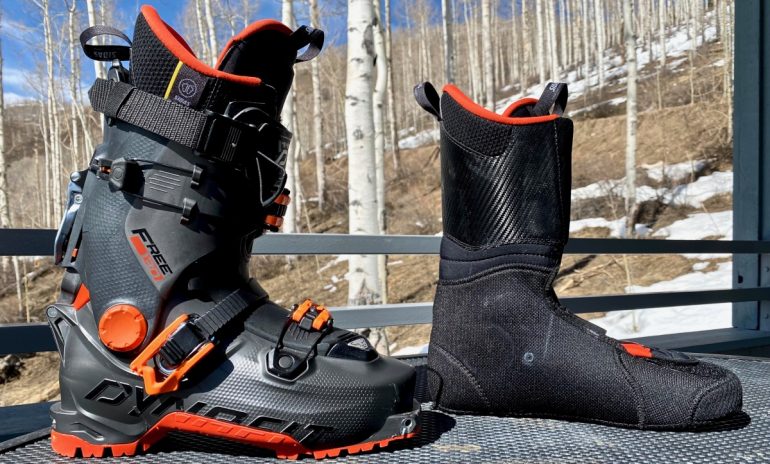
Powerful and agile, the Hoji Free will easily boss around big skis in tight spaces and variable alpine conditions. Photo: Riley Soderquist
On an early March day in the Elk Mountains near Aspen, Colorado I found myself atop a 3,000ft descent in hero snow that aligned with favorable stability. Having spent the three months prior guiding clients in my lighter, more touring-oriented boots, I was predisposed to firing off countless precise turns down the middle of the line looking for the most consistent snow and terrain. However, on this particular day, off the clock and with the Hoji Free boots driving freeride oriented skis, I found myself re-interpreting a line that I had skied many times before. This time I was seeking out undulating micro terrain and pillows built on buried timber from last year’s historic avalanche cycle. Turn, slash, air, point it, turn, and repeat. Linking feature-to-feature with variable radius turns and slashing my way down, I was laughing out loud at how effortless and fun it all was. In an industry often focused on shaving grams, I was reminded that at times this can come at the expense of pure skiing pleasure. The Hoji Free was designed to dish up the fun.
The Hoji Frees aren’t the lightest in their segment, or the stiffest for that matter, but they do have a huge sweet-spot and will easily drive whatever plank you choose to pair them with. The Hoji Free offers a 130 flex boot with 55 degrees of cuff rotation in a 102mm last at 1,550 grams (size 26.5).
My previous go-to beefy touring boot was the Dynafit Vulcan. As a 1,000 plus day user of the Vulcan (multiple pairs), I have tried and failed to find a boot with a similar or better balance of uphill/downhill performance. Could the Hoji Free be the boot that finally retires the venerable Vulcan from the feet of countless guides, connoisseurs, and discerning dirtbags?

Though best appreciated on the descent, I suppose heavier boots kick the best steps. Photo: Anton Sponar
Where the Vulcan relied on its removable tongue to provide downhill performance when inserted and allowed for more cuff articulation on the skintrack when removed, the Hoji Lock System on the Hoji Free simplifies the transition and does so with a much more robust cuff welding mechanism. With a similar last, cuff height, articulation and almost identical weight, it was an easy transition for my physiology between the two models with zero boot fitting work. The bottom line is that the Hoji Free puts more power to the ski in a package that requires substantially less fuss at transition time. With the arrival of the Hoji Free in my stable of boots, the old Dynafit Vulcans are already collecting dust.
Built around the Hoji Lock ski/walk architecture, the Hoji Free offers the promise of a seamless transition between ski and walk mode with the throw of one lever and no fiddling with individual buckles. The system works by cable tensioning the powerstrap and upper buckle in a single motion when engaged. It has one of the better mitten/glove friendly levers across all of the freeride oriented touring boots, does not jam with snow and does not require the fore/aft dance to engage like some other boots with external bar/lever locking mechanisms. However, I found that if I buckled the boot to my downhill preference and then opened it to tour, the walk mode was slightly restricted. This is not a big deal for side-country style touring, but I found myself resetting the buckles any time that I expected a lengthy climb to take full advantage of the cuff flexion.
A beefier and more versatile relative of the Hoji Pro Tour, the Hoji Free ups the performance ante with a narrower last, Grilamid/fiberglass cuff, custom SIDAS liner and a toe weld. This evolution also addressed the questions of crampon and binding compatibility that turned some buyers away from the Speed Nose design of the Hoji Pro Tour.
Unsurprisingly, the Hoji Free shines on the downhill. On more minimal and lightweight boots I tend to give very deliberate inputs when driving skis, especially in variable conditions. Conversely, the Hoji Free can boss around whatever ski of obscene width or length that you may choose to attach to your feet with ease. This results in a much more natural and relaxed set of inputs to the ski. I find myself effortlessly transitioning between carving, slarving and launching my carcass off of whatever pillows I can find. It’s a refreshing experience after having spent many days this year firing off very consistent and calculated turns in light and fast touring oriented boots. With the Hoji Free, putting power to the tips of the skis comes easily and an included spoiler can be added to the cuff that places the user in a more forward biased stance if preferred.
The SIDAS liner in the Hoji Free deserves a special mention as it is a significant departure from the proprietary liners found in most Dynafit boots. More akin to a downhill boot liner, it offers greater support and volume to mold than standard touring boot liners, but doesn’t inhibit touring capability like an aftermarket power-wrap liner.
A note to prospective buyers, this boot fits big. I usually ski a 27.5-28.0 boot and found myself taking it all the way down to 26.5 to get a performance fit from the Hoji Free. In the free-touring segment of boots, it all comes down to fit. If you are looking for downhill performance, and a racy fit, then what actually matters is which particular boot fits your unique feet. Chances are a wide foot won’t be happy in a Tecnica Zero G Tour Pro and a narrow foot will swim in a Hoji Pro Tour. The Hoji Free exists somewhere in between with a moderately wide last at 102mm. Since fit is such a nuanced and important part of picking a boot, I always prefer working directly with a knowledgeable shop when possible.

The Hoji Free effortlessly gobbles up a powdery descent with minimal inputs, encouraging the user to open it up and get playful with the terrain. Photo: Anton Sponar
In the muddled world of boot sole and binding standards, the Hoji Free offers much more versatility than the Hoji Pro Tour. As an ISO 9523 certified boot, the Hoji Free is compatible with touring frame bindings according to Dynafit. Where it gets a little confusing is when it comes to MNC bindings like the Salomon/Atomic Shift. Some fine print says boots such as the Hoji Free, with Dynafit Quick-Step-In (QSI) inserts, are not compatible with the Shift Binding, but then other documentation will contradict this notion. For an in-depth exploration of this topic, see Lou’s investigation of QSI/Shift compatibility. If you aren’t willing to be held hostage by the proprietary Salewa crampons (cramp-ins) required on a Hoji Free Tour or want a beefy touring boot that you may be able use with bindings that require a toe weld then the Hoji Free may fit your needs.
True to the style of their namesake Eric Hjorleifson, the Hoji Free encourages fast, loose and playful skiing. If you aren’t afraid to haul around a little more weight on your feet than the more touring oriented boot models, the Hoji Free will reward you with fun in spades. After a series of false starts with the Khion and Beast boots, it’s great to see Dynafit back in the free-touring game with an honest contender.
SPECS
Dynafit Hoji Free
Weight: 1550g (26.5)
Flex: 130
Last: 102mm
Cuff Rotation: 55 Degrees
Boot Sole: Pomoca Formula Climb
Boot-Binding System: Dynafit Quick-Step-In
Forward Lean: 11? when locked
Construction: Gilamid shell with Grilamid/fiberglass composite cuff
MSRP: $899.95
Shop for it. And check out our plethora of other Hoji content.
Nate Rowland is a year round guide living with his wife and three young boys at 9,500ft on the fringes of Aspen, Colorado. He is a member of Mountain Rescue Aspen, a Voile Ambassador and works in product testing and validation with The North Face. If encountered in the wild, he responds well to chocolate milk and pickled herring. Follow him at @aspenate.
Nate Rowland is a year round guide living with his wife and three young boys at 9,500ft on the fringes of Aspen, Colorado. He is a member of Mountain Rescue Aspen, a Voile Ambassador and works in product testing and validation with The North Face. If encountered in the wild, he responds well to chocolate milk and pickled herring. Follow him at @aspenate.

